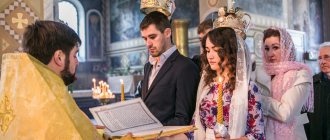Why do you need to get married?
A wedding is a divine service during which one of the seven church sacraments is performed - the Sacrament of Marriage. In the “Orthodox Catechism” of St. Philaret of Moscow (a church textbook that for almost a hundred years has had no competitors in its simple and accurate presentation of the foundations of the Orthodox faith), the following definition of Wedding is given:
“Marriage is a Sacrament in which, with the bride and groom freely promising mutual marital fidelity before the priest and the Church, their marital union is blessed in the image of the spiritual union of Christ with the Church and they ask for the grace of pure unanimity for the blessed birth and Christian upbringing of children.
The fact that marriage is a Sacrament is clear from the following words of the Apostle Paul: “A man will leave his father and mother and be united to his wife, and the two will become one flesh. This mystery is great; I speak in relation to Christ and to the Church" (Eph. 5:31-32)"
From here it is obvious that during the wedding the bride and groom receive special grace for their married life in all its aspects, including the birth and upbringing of children. Accordingly, people come to get married when they feel the need to bless their family union and are ready to receive these gifts.
Sometimes the question arises: what changes in the lives of spouses after the wedding? Everyone answers it differently. Some people's lives are noticeably changing for the better, some don't see any changes, and some regret taking on additional responsibility and extra obligations. Why does this happen if grace is poured out to everyone equally during the Sacrament?
There are two main reasons here: the initial motivation (and the internal state of the newlyweds) in preparation for the Wedding and their subsequent attitude towards the gifts received in the Sacrament. Any gift can be used or not used, thrown into the far corner of your life - maybe when you need it later. And if the gift received was lost through negligence, then it is not surprising that the life of those who lost what they received is no different from the life of those who have not yet received the gift.
What are the benefits of getting married in a church?
With the revival of Orthodoxy in Russia, church sacraments became accessible and open. Now that there is no longer any fear of punitive action at the state level and religious life has again become an integral part of life, church services have become in demand among the population. The most popular wedding remains the most popular, not only among young people, but also among couples living in a long-registered marriage.
People strive to be closer to God, to live according to his commandments and under his protection. And for a family that has just appeared, this blessing of God is very important. This helps to build your family harmoniously in the same faith and mutual love, as well as raise and educate children within the framework of Christian values and morals. A wedding strengthens a young family on a spiritual level. A married couple is already strong because they are united.
Myths about weddings
There are many myths about weddings, they are tenacious and diverse. These are, perhaps, the top ones today.
Myth No. 1. Wedding is fashionable.
The myth is not true. In fact, it is now very fashionable to talk intelligently about the fact that weddings are fashionable. There are so many people who are guilty of this activity, and they sometimes behave so aggressively in their “educational” activities that one can only wonder - is this one of the ways to assert oneself?
Myth No. 2. Only people who are very deeply religious can get married..
A continuation of the previous myth, it is expressed in the context of “well, you definitely don’t have the right to get married, because you rarely pray, you fast little, and in general, you don’t believe deeply enough!” Measuring the depth, width and height of someone’s faith is a thankless and dangerous task, especially since in the end everyone will have to answer primarily for themselves. The list of obstacles to a wedding does not contain such an item as “insufficient depth of faith.”
Myth No. 3. Getting married at the beginning of family life is too early. You need to live together for 10-15 years, make sure your intentions are serious.
It is certainly necessary to make sure of the authenticity of feelings and the seriousness of intentions. And it’s more logical to do this not only before the wedding, but also before going to the registry office, having children together and taking out a mortgage together. And if you want to arrange a probationary period for each other for five years (and why exactly five? Not three, not ten, not fifteen? And even after the silver wedding, some get divorced!) under the weight of doubts and because of mutual distrust - maybe it’s not worth starting?
Myth No. 4. Getting married not at the beginning of family life is too late.
It's never too late to get married!
Myth No. 5. A real marriage is only a married marriage. Families who have limited themselves to registering at the registry office live in sin.
The myth does not correspond to the teachings of the Church, but is still supported by some clergy. The problem was especially acute in the 90s - so much so that it was brought up for discussion at the Synod. The Holy Synod of the Russian Orthodox Church on December 28, 1998, with regret, Fr. The definition adopted by the Synod states: “Insisting on the need for church marriage, remind pastors that the Orthodox Church respects civil marriage.” (the words “civil marriage” mean a marriage registered in the registry office between citizens).
Archpriest Vladimir Vorobyov in his “Lectures on the Sacrament of Marriage” also debunks this myth: “It is unacceptable and absurd to say that an unmarried marriage is fornication. If someone foolishly tells you this, remember that this is not church teaching. What the Lord said about marriage, what the apostle said about marriage. Paul, is in direct contradiction to this teaching. The Church has always accepted marriage as a kind of legitimate family arrangement of life. The Church has always paid tribute to this marriage and considered this marriage to be a completely worthy and blameless way of life. And the Church has never seen any sin in this. It’s just that a marriage can be church or non-church, but it is marriage, not fornication. Fornication is cohabitation outside of marriage, illegal cohabitation, i.e. cohabitation of people who do not want to have a family, do not want society to perceive them as a family, do not want to formalize their relationship legally.”
Ready - not ready
— If this is such a serious step, is it worth taking it right away? Some couples put off getting married because they don't feel ready enough...
- It happens. You see, this process of maturation before wedding occurs in parallel with churching.
I know spouses who are believers and church people, who have been married for about 50 years, but who at the same time are not yet mature enough to come to church and get married. There is no such spiritual kinship or unity between them to perform this Sacrament - the process is not yet completed. There are many such examples.
- Is this more good than bad?
- This is bad. But if they got married and after that nothing changed in their lives, it would be even worse.
I rather like the position of those non-church young people who, having had a wedding, are in no hurry to get married right away. There is a sound grain here: it demonstrates responsibility. Such spouses must live in a legal marriage, give birth to children, love each other, slowly change themselves, join the church and, when they grow up to a church marriage, get married.
However, if people have been living a full church life for quite some time, if each of them has come to know Christ in their own way and lives by Him, then for such people to get married without having a wedding is abnormal and more than strange. When believers, church-going spouses for some reason do not get married, this should lead to the thought: something wrong is happening here.
- Why? If this is “ripening”, then it occurs in different couples at different times...
— Because for a Christian, marriage and family are not just a “unit of society,” and certainly not “an institution for the legal use of each other.” This is a living example of how completely independent and separate individuals can coexist in complete unity. The family represents unity: everyone lives according to the law of love and at the same time no one suppresses, absorbs, or displaces anyone. An analogy can be drawn with the Holy Trinity: God the Father, God the Son, God the Holy Spirit live in complete love, complete harmony and unceasing self-giving to each other, and in this they acquire the absolute fullness of being and the very bliss to which we are all called. And therefore, for the Church, marriage is one of the fundamental concepts.
The relationship between Christ and the Church is identified by the Lord himself with marriage relationships: the Church is called the Bride of Christ. The Apostle Paul and all the holy fathers have this marriage allegory to one degree or another. And this only says that there is no higher relationship in a person’s life that is more conducive to salvation than marriage. We can safely say that marriage is a kind of “springboard” to salvation. But just as various risks are associated with a springboard, the same is true with marriage: without taking this path, you will not reach certain heights and will never know what free-fall flight is, but having entered, you must understand that they are not waiting for you. only shining peaks, but also the danger of breaking your back.
— Can spouses go to a wedding as a conscious step towards unity? Asking God for support in this?
- Yes, this is the most correct approach.
If a husband and wife have a desire to organize their lives in a Christian way, of course, it is better for them to enter into marriage through the Sacrament of Wedding. But this is only possible when each of them understands the full extent of the responsibility that he assumes. The responsibility is not only that they do not have the right to divorce, no matter what happens to them, but the responsibility is spiritual. For the way of life that each of them, according to his own strength, is trying to implement in accordance with the Gospel commandments.
— It turns out that this Sacrament is both the beginning of something qualitatively new and the pinnacle of some internal process?
“In this case, a wedding is truly both an important beginning and a peak, a kind of evidence that the spouses have truly achieved some kind of spiritual unity; in their aspirations to God, their trajectories have ceased to be parallel and began to strive for unity. In this case, the desire to receive a church blessing and sanctification of marriage becomes a completely natural and legitimate desire.
How to prepare for a wedding?
First of all, you need to fully understand what a Wedding is, what it gives to a person and what it obliges you to. Here literature can help (I especially like the books on this topic “The Sacrament of Love” by Metropolitan Anthony of Sourozh and “Love is Long-Suffering” by Archbishop John of Belgorod and Stary Oskol), and preliminary conversations in churches (in some city churches the bride and groom are recommended to attend public conversations ), and everyone’s own life and prayer experience.
Christians prepare for any serious event in their lives with confession and Communion - this is usually done before the Wedding. Sometimes the question arises: should we take communion on the wedding day, or the day before, in advance? Here both options are correct, each has its own advantages.
The tradition of the joint Communion of the bride and groom on their wedding day goes back to those distant times when Marriage as a separate church sacrament did not yet exist. The ceremony of weddings began to take shape quite late - only in the 9th century, when the next Byzantine emperor issued a decree that only church marriage was considered legal. Before this, for several hundred years, Christians got married quite simply: during the main service - the Liturgy - they were declared husband and wife in front of the Church and shared communion together. Now, the Church was forced to take over the functions of the registry office, the Sacrament of Marriage was separated from the Liturgy.
Today, the ceremony of the “common cup” during the Wedding and the laudable desire of some newlyweds to receive communion on their wedding day remind us of those distant times. However, the more troubles left for the bride and groom to organize the wedding, the less opportunity they have to fully prepare for such Communion (fast for several days, read “Following to Communion” and confess) - it is better in such circumstances to take Communion in advance.
There is no strict requirement to confess and receive communion in the exact church where the wedding will take place, but it is usually more convenient to do just that.
As for the functions of the registry office, now in our country the Church does not perform them - ever since it was separated from the state under Soviet rule. Therefore, marriages are registered - and receive legal status - at the registry office before the wedding. It’s not that it’s absolutely forbidden to get married without a stamp in your passport - as an exception, sometimes they do get married, but the priests are extremely reluctant to do this. It is better not to create such an ambiguous situation, and plan the Wedding either on the day of registration at the registry office, or after it, and take the documents confirming the registered marriage - passports and marriage certificate - with you to the Wedding.
In addition, for the wedding you will need to purchase in advance:
· Wedding icons
– traditionally these are icons of Jesus Christ and the Virgin Mary made in the same style; they can be completely new - purchased or made to order, or family icons passed down from generation to generation;
· two large wedding candles
(just large church ones are also suitable - enough for forty minutes, or you can buy special ones for a Wedding - they are decorated in every possible way and are sold in pairs at once);
· white towel
(aka board, aka foot) on which the bride and groom stand during the wedding - you can sew and embroider them yourself (embroidery and lace around the edges are not prohibited), you can order them, or take them out of grandma’s chests, who have them, or just buy ready-made ones (they are sold in church shops).
I won’t remind you that those getting married should wear crosses -
Orthodox Christians usually do not take them off at all.
Everyone also guesses for themselves how to buy wedding rings Rings can be anything - even gold, even silver, even tin. The quantity and quality of stones and other decorations are also regulated only by the taste of the couple. However, if you want to follow tradition in this matter, then buy one ring in gold and the other in silver.
Before the wedding, it will not be amiss to once again read those fragments from the Bible that are read during this Sacrament: the Gospel of John (chapter 2) and the Epistle of the Apostle Paul to the Ephesians (chapter 5). Although it is even more useful to familiarize yourself with all the stories of the Bible (even in a retelling) - during the wedding service, Old Testament families are also repeatedly mentioned: Abraham and Sarah, Isaac and Rebecca, Jacob and Rachel. To a trained person, the meaning of what is happening will be clearer.
Basic wedding rules
1. A wedding takes place only if both the bride and groom are baptized and belong to the Orthodox faith. In rare cases, the church may make an exception for representatives of non-Orthodox Christians (Anglicans, Catholics and Lutherans).
If you are going to connect your life with a Muslim, Judaist or Buddhist, and are also closely related to your other half (up to the fourth generation), you will have to limit yourself to civil registration. For some unknown reason, two brothers who are planning to marry two sisters will also be denied a wedding.
2. In Russia it is allowed to get married only from the age of 18.
3. Please also take into account the fact that a woman is prohibited from appearing in the temple during critical days. That is why you should calculate the date of menstruation in advance. If she falls just on the day of the wedding, postpone her arrival with special tablets or choose another day to perform the ceremony.
Choose time and place
You can be baptized on any day, but there are some restrictions regarding weddings. The Sacrament of Marriage is not performed:
· during multi-day fasts
(there are four of these in a year: the Nativity Fast is always from November 28 to January 6, the Assumption Fast is from August 14 to 27, the Great and Petrov fasts depend on the date on which the Easter holiday falls in the current year, approximately the Great Fast is March-April, Petrov - from June to July 11);
· during Maslenitsa
(also called cheese week);
· during Holy Week
(the first week after Easter) and
Christmastide
(from January 7 to January 19);
· on the eve of fasting days - Wednesday and Friday, and on the eve of Sunday, that is, on Tuesdays, Thursdays and Saturdays
during the whole year;
· on the eve of the twelve and great holidays;
· on the eve and on the day of the feast of the Beheading of John the Baptist ( September 10 and 11
);
· on the eve and on the day of the Feast of the Exaltation of the Holy Cross (September 26 and 27);
· on the eve of the patronal feast days of the church in which they plan to perform the Sacrament.
An exception to these rules can be made only with the blessing of the ruling bishop, and then in the presence of emergency circumstances. Therefore, you need to choose the date carefully, sign up for the church in advance (especially if it is not entirely clear when the patronal holidays are there) - in order to book a more convenient wedding time - now in the churches of Yekaterinburg Weddings are performed individually (the bad practice of marrying several couples at the same time has become a thing of the past along with severe shortage of churches and priests).
Choosing a church for a wedding is easiest for those who are already regular parishioners of a particular church - in this case, they get married there. The rest have something to think about: they usually do not marry (with rare exceptions) only in monastery churches, while the rest - large and small, in the center and on the outskirts - are at your service. Each has its own advantages: a large cathedral is more solemn, more guests can fit in and you can order bells to complete the picture; in a small church it is more comfortable and there are fewer non-wedding people visiting. Let me just say that the slogan “not in the cemetery church!” - a petty superstition that has nothing to do with the festivity of the wedding itself, or the well-being of future family life.
Some churches ask separately whether a choir is needed for weddings. Needed! Of course, the holiness of the Sacrament will not be diminished by the absence of singers, but the loss in beauty will be significant.
The question about photo and video shooting during the Wedding also needs to be clarified in advance - it is not allowed everywhere, although there is nothing seditious about it. But we remember where we go with our charter, and where we don’t go, so it’s easier to immediately sign up for a wedding where a photographer is allowed to appear if you need wedding photos.
Bride's wedding dress
For a wedding, choose a modest dress with a long skirt, closed back and sleeves. For low-cut or revealing outfits, we recommend choosing a bolero or cape; they will allow you to look appropriate for the church.
Colored wedding dresses are not suitable for weddings; give preference to classic shades - white, light beige, ivory. Pay special attention to the choice of shoes. There is no point in tormenting your feet with high heels, because you have a wedding party ahead of you. And think about the witness! Especially for a wedding, choose shoes with small heels or solid soles; after the ceremony, you can always change your shoes.
Be sure to cover your head with a veil or scarf. A small hat is allowed. But if the crown is placed on the head, it is better to avoid fluffy hairstyles and headdresses, otherwise it may simply not fit.
The rites of the Sacrament of Marriage: step-by-step details
The church rite of marriage consists of two separate parts: the betrothal (that is, the exchange of wedding rings) and the wedding. The first part, the betrothal, is preparatory, and the second, the wedding itself, is the main part, the secret part. A wedding is a very beautiful and spectacular service, including because the bride and groom do not just passively listen to prayers, but are themselves active participants: they exchange rings, answer the priest’s questions, perform a religious procession wearing crowns, and try to literally drink to the bottom of a common bowl.
Engagement
This stage of marriage is familiar even to those who have never been to a wedding, since it was the exchange of wedding rings between the bride and groom that took root in Soviet registry offices as the central event of the marriage ceremony between two citizens of the USSR. In the same form, the ceremony migrated to the registry offices of the Russian Federation.
Betrothal is actually a separate rite; in ancient times it was performed in advance, sometimes long before the wedding itself. In the West, it remained on its own, transforming into a modern engagement. Since the 18th century, betrothal and wedding have taken place simultaneously.
Church betrothal - and, in fact, the entire wedding ceremony - begins with the priest blessing the bride and groom with lighted candles. The future spouses should hold these wedding candles in their hands almost until the end of the service, only sometimes parting with them for a short time (in such cases they can be temporarily entrusted to the best men).
Then the priest takes out the consecrated wedding rings (also called rings) from the altar. According to tradition, the groom's ring (which he gives to the bride during the exchange of rings, so that in the end - after the engagement - it will be the wife's ring) was gold, the bride's ring was silver.
Why is this so? There are several versions, one of them, for example, is that a gold ring emphasizes the primacy of the husband. According to another, the golden ring symbolizes the sun with its brilliance, the silver one - the likeness of the moon, shining with reflected sunlight.
Taking the gold ring, the priest says three times : “The servant of God ( name)
) servant of God (
name
)
. Each time he pronounces these words, he makes the sign of the cross over the groom and puts the ring on the ring finger of his right hand. Then he takes a silver ring and baptizes the bride with it three times, saying: “ The servant of God (
name ) is betrothed to the servant of God (
name
)
” and also puts the ring on the ring finger of her right hand.
So, first the groom has a gold ring, and the bride has a silver one. Then they exchange rings three times - that is, each time they give rings to each other as a sign of love and far-reaching intentions, and the priest returns the rings back twice - to each his own - as if saying: “Think carefully, this is a serious matter!” For the third time, the rings remain with the new owners - the groom has a silver one, the bride has a gold one. The exchange of rings symbolizes giving of oneself to each other for life, the highest degree of mutual trust.
Everyone knows that “a wedding ring is not a simple piece of jewelry.” This is a sign of eternity, infinity and continuity of the marriage union - this is how we now perceive the symbolism of rings. Although there is a more practical and down-to-earth interpretation, Metropolitan Anthony of Sourozh cites it in his book “The Sacrament of Love”:
“In ancient times, people often did not know how to write, but could only certify a letter or document with a seal; and the decisive role was played by the ring on which there was a personal seal. The document sealed by this ring was undeniable. This is the ring that is mentioned in the engagement service. When a person gave a ring to another, it meant that he trusted him unconditionally, that he trusted him with his life, his honor, his property - everything. And that’s when the wedding couple exchange rings (I mean exactly exchange
, because each of them first puts on a ring and then gives it to his spouse three times) - when spouses exchange rings, they seem to say to each other: “I trust you unconditionally, I trust you in everything, I trust you with myself...” And “Of course, there cannot be such an exchange of rings between people who commit only a conventional marriage or a marriage without the intention of building a
common life
from the beginning to the last.” (with this interpretation, it would now be logical to replace the exchange of rings with the exchange of SIM cards and email passwords).
After the exchange of rings, the priest says a prayer in which a blessing is asked for the betrothed. In general, a Wedding is a service that is entirely devoted to prayers for two people: the bride and groom. From time to time, “the parents who raised them” are mentioned, but in general, everything is about the young and for the young.
Wedding
The engaged bride and groom go out to the middle of the temple and stand on a spread out white towel. Before proceeding with the Wedding, which, like any Sacrament, cannot be performed by force and requires voluntary participation, the priest asks the bride and groom (in turn) whether they really want and can marry each other.
First, the groom is asked: “Imashi (
name
), a good and unconstrained will, and a strong thought, take this wife (
name
), right here in front of you?
(which translated from Church Slavonic means “Do you have a sincere and spontaneous desire and firm intention to be the husband of (name of the bride) whom you see here in front of you?”), to which the groom must answer “Imam, honest father.”
The next question is: “ Did you make a promise to another bride?”
(here, I think, there is no need to translate - everything is clear).
If the groom answers: “ I didn’t promise, honest father
,” then the same two questions are asked to the bride. Having made sure that the bride does not object to the marriage, the priest begins the wedding.
After the prayer for the bride and groom, the main moment of the Sacrament comes: the crowns are brought out, and the priest places the crown on the head of the groom, saying: “The servant of God (name) is married to the servant of God (name) in the name of the Father, and the Son, and the Holy Spirit, amen
" Then he places the crown on the bride with the same words.
The crowns are either literally “laid” on the heads of both the groom and the bride, or the groomsmen have to hold them over the heads of the newlyweds the entire time the crowns must be “laid” - and this is not so little! Therefore, the height and athletic training of the groomsmen must be appropriate, especially if it is clear in advance that the bride’s hairstyle (or hat, or veil) will not allow the crown to be placed on her head.
The crowned bride and groom are blessed three times with the words “ Lord our God, crown me with glory and honor.”
"(in Church Slavonic the word “I” means “their”). This is the culmination of the wedding ceremony.
Here I would like to make a lyrical digression and talk about crowns. Christianity came to us from a Mediterranean country, where there was a tradition of dressing up in flower wreaths on holidays. The bride and groom also wore such wreaths on their holiday - marriage. And the Wedding took place there (some argue that this is still the case - I cannot confirm or refute) by placing flower crowns on the bride or groom, which in our snowy regions were transformed into special crowns, more similar to royal crowns than for flower wreaths.
The crowns placed on the heads of the bride and groom in the Sacrament of Wedding have several symbolic meanings. First of all, these are the Royal Crowns: the bride and groom become king and queen for each other (and for their future children), leading a new unit of society.
Another symbolic meaning of the crowns is not so joyful, but no less important: these are martyr’s crowns, symbolizing the cloudless nature of family life, where each spouse will have to show considerable patience, humility and love. “He who endures to the end will be saved.”
As at any other service, at the Wedding the Gospel and the Apostle are read in Church Slavonic. These are two fragments from the Bible dedicated to marriage and family life: from the letter of the Apostle Paul to the Ephesians (chapter 5, verses 20 to 33) and from the Gospel of John (chapter 2, verses 1 to 11). The Gospel tells about the very first miracle performed by Jesus Christ - the transformation of water into wine at a wedding in Cana in Galilee, and in the letter of the Apostle Paul - about the relationship between husband and wife.
After a prayer for the newlyweds, where they are asked for peace and unanimity until “venerable old age,” and the singing of “Our Father,” the priest brings out a cup of wine (usually this is a church basket - a small special ladle). The bride and groom take turns drinking from this cup three times. The groom starts, again, so everything that is left after the third time will have to be finished by the bride - the cup must be drunk to the bottom.
The symbolism of the common cup is as rich and beautiful as the symbolism of crowns and wedding rings. In the broadest sense, this is a cup of common life and destiny, now one for two, which must be drank by the spouses to the dregs, with all its joys and troubles (and everything that for some reason one of them did not drink enough, the other will have to disentangle) . In the context of the Gospel just read, the cup of wine is a reminder of how the Lord blessed wine at the wedding in Cana of Galilee. In historical retrospect, it symbolizes the Eucharistic chalice - that is, the one from which Christians receive communion during the Liturgy. This is not surprising - Wedding as a separate Sacrament developed quite late - in the ninth century. Before this, the bride and groom began their life together with a blessing and joint Communion - the marriage took place during the Liturgy.
After the bride has finished with the rest of the wine and drained the common cup, the priest joins the right hands of the newlyweds and covers them with stole, as if tying them before God. This begins a solemn procession around the lectern, on which lie the cross and the Gospel, symbolizing the life path of the new family, in the center of which should be the Word of God.
During the three-time circumambulation of the lectern, three troparions are sung. The first of them: “Isaiah, rejoice...” is joyful, it recalls the Divine blessing of childbirth and the fact that the Mother of God is the patroness of marriage.
The second - “Holy Martyrs ...” - is more minor, it seems to refer us to one of the interpretations of crowns and weddings - they are crowned not only for the kingdom, but also for martyrdom, for a feat. The feat of family life will be difficult - there are no simple and easy marriages, but it can be victorious, just as the feat of the martyrs was victorious.
In the third troparion: “Glory to Thee, O Christ our God,” Christ is glorified as hope and help to husband and wife in all circumstances of their lives.
After this small procession of the cross (I note in parentheses that only the priest and the newlyweds participate in the procession if they are wearing crowns; if the best men hold the crowns all this time, then they, too, will have to walk around the lectern three times along with the newlyweds) the crowns are removed.
According to the practice accepted today, immediately after the final prayers of the wedding, a prayer is read for the permission of the crowns “on the eighth day.” The name of this prayer of permission captures an ancient tradition: once upon a time the Sacrament of Marriage was celebrated as if in time: after the wedding, the newlyweds went to church for a whole week in their wedding attire and wore those very flower crowns (in fact, the wedding was celebrated for seven days - like Easter! ). This tradition died out over time, but the name still remains.
The priest brings the newlyweds to the royal doors, where he blesses them with wedding icons (during the service, the icons are in the altar). The final chord of the holiday is mass congratulations to the newlyweds with the presentation of flowers and gifts and the constant performance of “many years”.
What is the meaning of a wedding?
The meaning of a wedding is to invoke the grace of God on a newly created family. During the Sacrament of Wedding, the priest, together with family and friends, prays for the sanctification of the union, for the blessing of the new family. He asks for God's help and mercy for the spouses throughout their entire life together. The newlyweds promise to be faithful to each other in Christ, to “bear each other’s burdens,” and to love and appreciate each other.
During the wedding, the spiritual unity of Orthodox spouses occurs, which they must preserve throughout their subsequent lives. And which will help them appreciate the joys and cope with the difficulties of their life journey together. Believing married spouses retain the hope that their souls, sealed by love and grace, will remain connected to each other even after physical death. After all, for God, an Orthodox marriage is concluded not only on earth, but also in Heaven.
Dress code and face control
Who can be invited to the wedding as guests? Everyone the bride and groom want! Rumors that one of the newlyweds' relatives (parents, godparents, children and grandchildren) cannot attend the wedding have no basis. There are benches in churches for grandmothers, although everyone usually forgets about them.
Sometimes the question arises of what the bride should wear, especially if the wedding takes place much later than the registration of the marriage and all the wedding celebrations. In this case, a white wedding dress is not at all necessary, although absolutely the bride (like all the other ladies who came) should NOT be wearing trousers and with her head covered (veil, hat, scarf, etc. - the choice is huge). It is also not customary to go to church in a mini dress or with bare shoulders. Well, we choose shoes so that you can stand in them for a long time without harming your health.
How does a wedding take place and what is needed for it?
What you need to bring to church for the wedding:
- icons: the Savior and the Mother of God;
- white handbrake;
- wedding candles;
- cahors.
All these things can be purchased at the shop at the temple. The recommended pair of icons is considered wedding .
The icon of the Savior is used to bless the spouse as the protector of his family. And the icon of the Mother of God is a spouse, like a mother and keeper of the family hearth
During the wedding, witnesses also play their role. They are called recipients because they agree that the young people have decided to get married in the church. Witnesses must also be Orthodox and baptized, close people of the newlyweds.
How does the wedding take place - the whole process is divided into 2 stages : engagement and the wedding itself. After the Divine Liturgy, the bride and groom are betrothed and blessed by the priest.
After the newlyweds confirm that they are getting married voluntarily, the sacrament of Marriage begins. Crowns are placed on the heads of the bride and groom, supported by witnesses. The priest reads the sacred texts and joins the hands of the spouses. Then the young drink Cahors filled in special bowls.
Bowl with Cahors
Church and canonical obstacles to wedding
1. An obstacle to a wedding is the close degree of relationship between the bride and groom, both blood (up to the fourth degree) and non-blood (for example, two brothers cannot marry two sisters).
2. A wedding is impossible if one of the future spouses is not baptized or declares himself an atheist. In some cases, it is possible to marry Christians of other faiths. Here is what is written on this topic in the “Fundamentals of the Social Concept of the Russian Orthodox Church”:
“In accordance with ancient canonical prescriptions, the Church even today does not sanctify marriages concluded between Orthodox Christians and non-Christians, at the same time recognizing them as legal and not considering those in them to be in fornication. The Russian Orthodox Church, both in the past and today, finds it possible for Orthodox Christians to marry Catholics, members of the Ancient Eastern Churches and Protestants who profess faith in the Triune God, subject to the blessing of the marriage in the Orthodox Church and the upbringing of children in the Orthodox faith. The same practice has been followed in most Orthodox Churches over the past centuries. An example of mixed marriages was many dynastic marriages, during which the transition of the non-Orthodox party to Orthodoxy was not mandatory (with the exception of the marriage of the heir to the Russian throne). Thus, the Reverend Martyr Grand Duchess Elizabeth entered into marriage with Grand Duke Sergius Alexandrovich, remaining a member of the Evangelical Lutheran Church, and only later, of her own free will, accepted Orthodoxy.”
3. It is not permissible to enter into a marriage with a person who is actually married to another person (for this reason, before the wedding they are asked to present passports or a marriage certificate).
4. Another obstacle is the spiritual relationship between godfathers who baptized one child and between godparents and godchildren. On this occasion, one can recall an instructive episode from the life of the holy Equal-to-the-Apostles Princess Olga, who came to Constantinople to be baptized and unexpectedly received a marriage proposal from the Greek Tsar-Emperor. Remarriage was not part of her plans, but it was also dangerous to quarrel with the emperor, offending him with a refusal. Then Olga said: “I came here for the sake of holy baptism, and not for the sake of marriage; When I am baptized, then we can talk about marriage, for an unbaptized wife is not ordered to marry a Christian husband.” And just before Epiphany, Olga asked the Tsar himself to become her godfather. The flattered Tsar agreed, and when after some time he again started talking about the wedding, Olga was indignant: “How can you, your goddaughter, take me as your wife? After all, not only according to Christian law, but also according to pagan law, it is considered vile and unacceptable for a father to have a daughter as a wife!” They parted on good terms, but not married.
5. You cannot marry those who have taken monastic vows, as well as priests and deacons after their ordination. As they say, the priest’s last wife is the priest’s wife.
6. Marriage is not allowed more than three times.
7. A temporary obstacle to the participation of women in any church Sacraments - including Weddings - are the “critical days” and the first forty days after childbirth.
But pregnancy does not impose any restrictions on participation in church sacraments - including the Sacrament of Marriage. Unless it will be a bit difficult for a pregnant bride to stand during the wedding (guests can sit down in this case, but the bride and witness need to realistically assess their strength).
Why is a wedding necessary?
In the life of a Christian, God's blessing is of great importance. We pray in the morning, before going to bed, and on Sunday we dedicate the day to God by visiting temple. We take the blessing of the priest for every good deed. The death of a Christian is also associated with prayer . Moreover, believers want to receive God’s blessing for such an important event as marriage. After all, Orthodox Christians are chaste and want to have only one companion for life.
God's blessing for marriage is given in the Sacrament of Wedding, in which the priest reads prayers for mutual love and understanding of the spouses, for the gift of children. For a religious person, civil registration cannot be fully perceived as marriage. He needs the Sacrament to understand that a family has been created.











